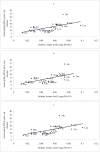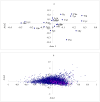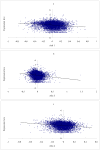Hydrophobicity and aromaticity are primary factors shaping variation in amino acid usage of chicken proteome
- PMID: 25329059
- PMCID: PMC4199684
- DOI: 10.1371/journal.pone.0110381
Hydrophobicity and aromaticity are primary factors shaping variation in amino acid usage of chicken proteome
Abstract
Amino acids are utilized with different frequencies both among species and among genes within the same genome. Up to date, no study on the amino acid usage pattern of chicken has been performed. In the present study, we carried out a systematic examination of the amino acid usage in the chicken proteome. Our data indicated that the relative amino acid usage is positively correlated with the tRNA gene copy number. GC contents, including GC1, GC2, GC3, GC content of CDS and GC content of the introns, were correlated with the most of the amino acid usage, especially for GC rich and GC poor amino acids, however, multiple linear regression analyses indicated that only approximately 10-40% variation of amino acid usage can be explained by GC content for GC rich and GC poor amino acids. For other intermediate GC content amino acids, only approximately 10% variation can be explained. Correspondence analyses demonstrated that the main factors responsible for the variation of amino acid usage in chicken are hydrophobicity, aromaticity and genomic GC content. Gene expression level also influenced the amino acid usage significantly. We argued that the amino acid usage of chicken proteome likely reflects a balance or near balance between the action of selection, mutation, and genetic drift.
Conflict of interest statement
Figures





Similar articles
-
Base composition is the primary factor responsible for the variation of amino acid usage in zebra finch (Taeniopygia guttata).PLoS One. 2018 Dec 5;13(12):e0204796. doi: 10.1371/journal.pone.0204796. eCollection 2018. PLoS One. 2018. PMID: 30517105 Free PMC article.
-
A simple model based on mutation and selection explains trends in codon and amino-acid usage and GC composition within and across genomes.Genome Biol. 2001;2(4):RESEARCH0010. doi: 10.1186/gb-2001-2-4-research0010. Epub 2001 Mar 22. Genome Biol. 2001. PMID: 11305938 Free PMC article.
-
Codon Usage Optimization in the Prokaryotic Tree of Life: How Synonymous Codons Are Differentially Selected in Sequence Domains with Different Expression Levels and Degrees of Conservation.mBio. 2020 Jul 21;11(4):e00766-20. doi: 10.1128/mBio.00766-20. mBio. 2020. PMID: 32694138 Free PMC article.
-
Main Factors Shaping Amino Acid Usage Across Evolution.J Mol Evol. 2023 Aug;91(4):382-390. doi: 10.1007/s00239-023-10120-5. Epub 2023 Jun 1. J Mol Evol. 2023. PMID: 37264211 Review.
-
Analysis of codon usage patterns in Taenia pisiformis through annotated transcriptome data.Biochem Biophys Res Commun. 2013 Jan 25;430(4):1344-8. doi: 10.1016/j.bbrc.2012.12.078. Epub 2012 Dec 23. Biochem Biophys Res Commun. 2013. PMID: 23268345 Review.
Cited by
-
Physicochemical Foundations of Life that Direct Evolution: Chance and Natural Selection are not Evolutionary Driving Forces.Life (Basel). 2020 Jan 21;10(2):7. doi: 10.3390/life10020007. Life (Basel). 2020. PMID: 31973071 Free PMC article.
-
Base composition is the primary factor responsible for the variation of amino acid usage in zebra finch (Taeniopygia guttata).PLoS One. 2018 Dec 5;13(12):e0204796. doi: 10.1371/journal.pone.0204796. eCollection 2018. PLoS One. 2018. PMID: 30517105 Free PMC article.
References
-
- Foster PG, Jermiin LS, Hickey DA (1997) Nucleotide composition bias affects amino acid content in proteins coded by animal mitochondria. J Mol Evol 44: 282–288. - PubMed
-
- Duret L (2000) tRNA gene number and codon usage in the C. elegans genome are co-adapted for optimal translation of highly expressed genes. Trends Genet 16: 287–289. - PubMed
-
- Kanaya S, Yamada Y, Kudo Y, Ikemura T (1999) Studies of codon usage and tRNA genes of 18 unicellular organisms and quantification of Bacillus subtilis tRNAs: gene expression level and species-specific diversity of codon usage based on multivariate analysis. Gene 238: 143–155. - PubMed
-
- Novoa EM, Ribas de Pouplana L (2012) Speeding with control: codon usage, tRNAs, and ribosomes. Trends Genet 28(11): 574–81. - PubMed
Publication types
MeSH terms
Substances
LinkOut - more resources
Full Text Sources
Other Literature Sources
Miscellaneous

